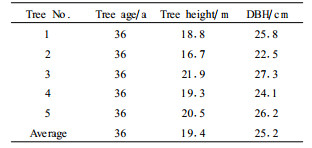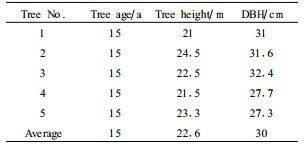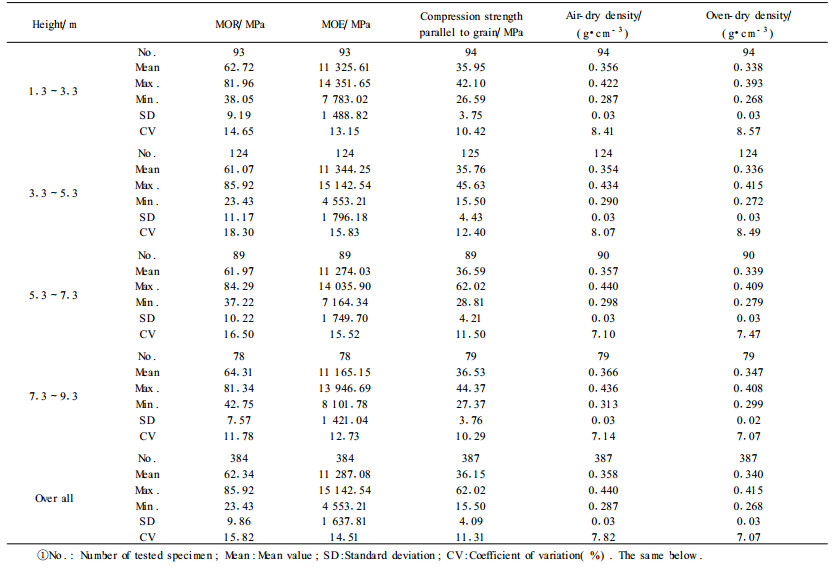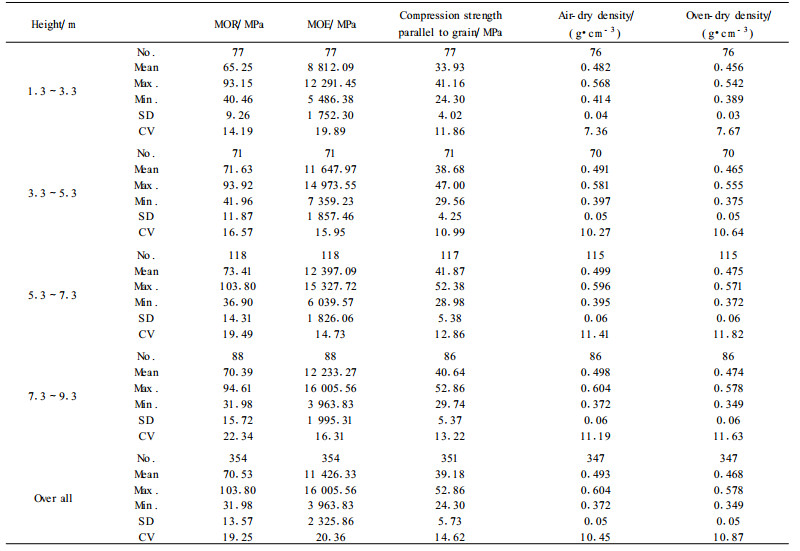文章信息
- Ren Haiqing, Takashi Nakai
- 任海青, 中井孝
- Intratree Variability of Wood Density and Main Wood Mechanical Properties in Chinese Fir and Poplar Plantation
- 人工林杉木和杨树木材物理力学性质的株内变异研究
- Scientia Silvae Sinicae, 2006, 42(3): 13-20.
- 林业科学, 2006, 42(3): 13-20.
-
文章历史
Received date: 2005-01-10
-
作者相关文章
2. 日本国际协力机构 北京 100091
2. Japan International Cooperation Agency Beijing 100091
China has the world's largest population of 1.3 billion. Unprecedented economic development and rapid population growth have resulted in a dramatic increase in wood consumption over the past decade. According to 1996 statistics (Wang et al., 1995), China annually consumed over 190 million m3 of fuel wood, 21 million m3 of sawn wood, 18 million m3 of wood panels, and almost 40 million tons of paper products. In order to meet the unprecedented demand for wood, China has to import a huge amount of wood and wood products. It is anticipated that the imports will continue to increase in the foreseeable future. Following a series of studies, decision-makers in China have concluded that China must intensify its reforestation programme to sustain its domestic wood supply. In addition, it is also important to pursue more efficient utilization of the existing forest resource, especially the plantation resource.
China's reforestation programme formally started in the 1960s. Hundreds of thousands of hectares of plantations are established each year. Today, China has the world's largest plantation resource, totalling 46.67 hm2 in 1999 or about 20% of the world's total plantations. As more and more plantations reach rotation ages and the "National Natural Forests Protection program" is being implemented, the wood supply in China depends increasingly on plantations. Therefore, effective and integrated forest management and efficient utilization of the plantation resource have become one of central issues in China's forestry sector. With the move to fast-growing and shorter-rotation, China's plantation-grown woods have considerably difference wood characteristics as compares to the natural forests (Bao et al., 2001). The changed wood characteristics affect wood processing and wood utilization significantly (Cheng et al., 1992). In the past, the impact of intensive silviculture on wood quality was ignored, and the fast-growing plantations were not established according to specific end uses. As a result, the harvested plantation timber often does not meet the end-use requirements. In addition, lack of knowledge of the wood properties and end uses of the plantations has led to inappropriate and inefficient utilization of the plantation resource (Bao et al., 1998). Therefore, more research is needed to better understand the wood properties and end uses of the plantation-grown woods as affected by intensive silviculture. A better understanding of the impacts of intensive silviculture on wood properties and end uses will help forest managers to establish high-quality plantation resource required by end users (Zobel et al., 1989; Zhang et al., 1997). A better understanding of the wood properties and end-use potential of the plantation-grown woods will also help the forest industry to utilize the wood resource more efficiently (Zobel et al., 1989; Zhang et al., 1997). In addition, the integration of wood quality attributes and end uses into forest management will help to maximize the value of the plantation resource (Zhang et al., 1997).
Chinese Fir and poplar are the most popular and commercial plantation species in China. They have covered 58.8% plantation area together with Masson Pine. Traditionally, Chinese Fir and poplar are usually used in constructions owing to their high quality. Some studies have given that the mechanical properties of Chinese Fir and poplar in plantations has somewhat difference from those in natural forest (Bao et al., 1998). The present study focuses on the variability of mechanical properties of the two species in plantations within tree, and evaluates the major mechanical properties of them by wood density.
1 Materials and methodsEvery five trees from Cunninghamia lanceolata (Chinese Fir) and Populus×canadensis cv. 'I-214' (I-214 poplar) plantation were collected in Shanxia Forestry Center, Dagangshan of Jiangxi Province and Zhangbaotun Woodland of Liaoning Province respectively. The detail information on the tree samples was shown in Tab. 1 and Tab. 2.
|
|
|
|
For each sample tree, 2 m long logs were cut at different height (1.3, 3.3, 5.3 and 7.3 m, respectively). Then the small clear wood samples of modulus of elasticity (MOE), modulus of rupture (MOR) in static bending, compression strength parallel to grain and wood density were cut in accordance with Chinese National Standards (GB 1927~1943-91). These three types of samples come from one wood strip. Sample position was marked on each specimen where "core wood" was defined as the portion close to pith and "outer wood" was defined as the portion near the bark in this Chinese Fir study.
As to I-214 poplar, the "transition section" was added which was defined as the portion between "core wood" and "outer wood".
The specimens were then stored in a conditioning chamber until it reached approximately 12% moisture content. Bending, compression and density test were carried out in accordance with Chinese National Standard. The air-dry density was calculated by air-dried weight and volume while oven-dry density was based on oven-dried weight and volume. The specimen of shear strength test was cut from broken bending test samples. Shear test were carried out in accordance with Japanese National Standard.
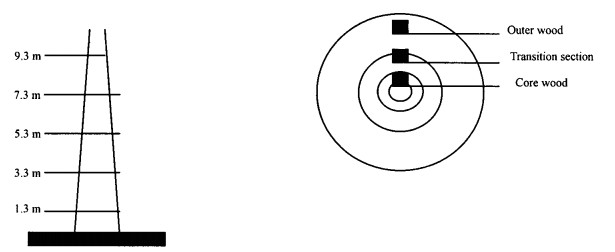
|
Fig.1 Specimen position in a tree and a disc |

|
Fig.2 Specimen position in a wood strip |
Tab. 3 had given that MOR of Chinese Fir increased slightly wavelike from breast height to 9.3 m height while MOE decreased contrarily from breast height to 9.3 m. The compression strength parallel to grain and air-dry density had the similar trend as MOR. ANOVA analysis showed that there were no statistically significant differences (at 5% level) among heights of these physic-mechanical properties as shown in Tab. 5. We may regard the main mechanical properties at breast height would reflect the mechanical properties of the whole tree.
|
|
|
|
Compared to the natural wood from the same site, the MOE of plantation wood was 26% higher than those natural wood whose MOE was 8 924 MPa, while MOR, compression strength parallel to grain and air-dry density were almost equal to the natural wood whose MOR, compression strength parallel to grain and air-dry density were 63.9 MPa, 35.2 MPa, 0.36 g·cm-3, respectively (CRIWI, 1982). Results from the study showed that the fast growing Chinese Fir in Jiangxi Province had the comparable properties and qualities to natural wood. It might give us an inspiration that better properties and high quality plantation wood could be obtained through suitable silviculture.
Tab. 4 showed that all the physic-mechanical properties of outer wood discussed in the study were higher than those of core wood. ANOVA analysis (Tab. 5) showed that all the physic-mechanical properties discussed in the study had a statistically significant (at 1% level) difference between core wood and outer wood. On the other hand, MOR and wood density had a statistically significant (at 5% level) difference between north and south direction.
|
|
Tab. 6 showed that Chinese Fir had a statistically significant (at 5% level) difference between radial and tangential section, while shear of tangential section was a little higher than that of radial section.
|
|
Tab. 6 also showed that shear strength of core wood was lower than outer wood in radial section, and there was a statistically significant (at 1% level) difference between core wood and outer wood. On the other hand, the shear strength of core wood was a little higher than outer wood in tangential section, but they had no statistically significant difference. In the case of different directions, Tab. 6 showed that the shear of north direction of Chinese Fir was a little higher than that of south direction in radial direction, while almost the same in tangential section.
2.1.2 Radial and axial variation of wood density and main wood mechanical properties of I-214 poplarTab. 7 showed that MOR, MOE and compression strength parallel to grain of I-214 poplar increased from breast height to 7.3 m height, but decreased a little at the 9.3 m height. On the other hand, air-dry density and oven-dry density increased from breast height to 7.3 m height steadily and kept same value at 9.3 m height. ANOVA analysis showed that MOR, MOE and compression strength parallel to grain had a statistically significant (at 1% level) difference among heights, while there was no significant difference of wood density among heights as shown in Tab. 9. Results from Tab. 7 showed the wood at 5.3~7.3 m height had the best mechanical properties, and the wood density at breast height could reflect the density of whole tree.
|
|
|
|
Compared to the natural wood whose MOR, MOE, compression strength parallel to grain and air-dry density were 71.5 MPa, 11 180 MPa, 33.0 MPa and 0.458 g·cm-3, respectively, the MOR of I-214 poplar in plantations decreased 1.4%, but the MOE, compression strength parallel to grain and air-dry density increased 2.2%, 18.7%, 6.5% (CRIWI, 1982).
Although lots of research had shown that fast growing or wider initial spacing had a negative effect on wood characteristics and lumber quality (McClain et al., 1994), in the case of Chinese Fir and I-214 poplar, it was possible to obtain the high quality wood from plantations from this study. The further study on getting better wood quality though silviculture of plantation should be continued.
Tab. 8 showed that the average MOE, compression strength parallel to grain and air-dry density of I-214 poplar in south direction were a little higher than those in north direction, while the average MOR of wood in the south was a little lower than those in the north. The oven-dry density was almost the same in two directions. Only the MOE of I-214 poplar wood increased steadily from pith to bark, and the MOR in north direction had the same trend. As to other physic-mechanical properties, the lowest value appeared in the transition section while the highest value appeared near the bark. ANOVA analysis (Tab. 9) showed that all the physic-mechanical properties discussed in this study had a statistically significant (at 1% level) difference between position from pith to bark, while there was no significant difference between north and south direction. The mechanical properties had a statistically significant (at 1% level) difference among heights.
|
|
Tab. 10 showed that shear strength parallel to grain of I-214 poplar had a statistically significant (at 1% level) difference between radial and tangential section, while shear of tangential section was a little higher than that of radial section.
|
|
Tab. 10 also showed that shear strength of core wood was lower than outer wood in radial section, and there was a statistically significant (at 1% level) difference between core wood and outer wood. On the other hand, the shear strength of core wood was a little higher than outer wood in tangential section, but they had no statically significant difference. In the case of different directions, Tab. 10 showed that the shear of north direction of I-214 poplar was a little lower than that of south direction in radial section, but shear properties of north direction was a little higher than that of south direction in tangential direction.
2.2 The relationship between physic-mechanical properties of wood from Chinese Fir and poplar plantationsFig. 3 to Fig. 5 had shown that the MOR, MOE and compression strength parallel to grain of Chinese Fir had a positive linear relationship with air-dry wood density. Apparently, MOR had a strong linear relationship with MOE (Fig. 6).
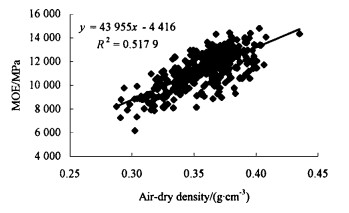
|
Fig.3 Relationship between density and MOE |
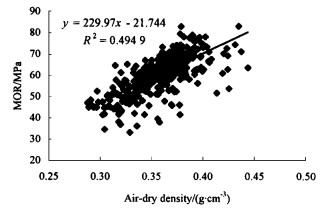
|
Fig.4 Relationship between density and MOR |

|
Fig.5 Relationship between density and compression strength parallel to grain |
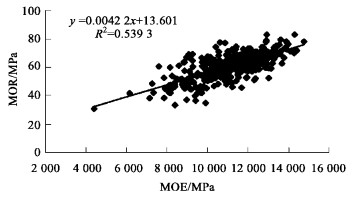
|
Fig.6 Relationship between MOE and MOR |
Because there was a linear relationship between some mechanical properties (MOR, MOE and compression strength parallel to grain) and wood density, and the density at breast height could represent the density of whole tree, so it would become possibility to predict wood mechanical properties and evaluate wood quality through wood density which would also cost less money and save much time.
Fig. 7 to Fig. 9 had shown that the MOR, MOE and compression strength parallel to grain of I-214 poplar had a positive linear relationship with air-dry wood density. The R2 value varied from 0.44 to 0.63. The MOE also had a strong linear relationship with MOR which R2 value was 0.58.

|
Fig.7 Relationship between density and MOE |

|
Fig.8 Relationship between density and MOR |
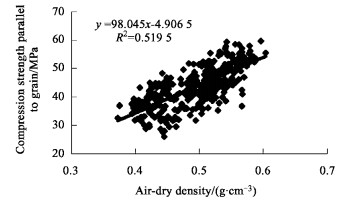
|
Fig.9 Relationship between density and compression strength parallel to grain |
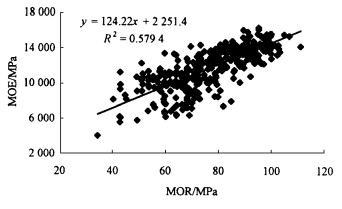
|
Fig.10 Relationship between MOE and MOR |
As same as Chinese Fir, this study had got simple models for predicting wood mechanical properties of I-214 poplar by wood density. Lots of studies has confirmed that wood density is an effective way to predict or evaluate wood mechanical properties (Koizumi et al., 2003), and ASTM standard also has introduced "density survey" concept in D2555. However, those results were limited to natural wood. There were still research on plantation wood confirmed positive linear relationship between some mechanical properties and density (Resch et al., 1978; Pearson et al., 1980). Because of the huge stocking volume of plantations in China, it was very necessary to look for a simple and effective way to predict wood properties. Wood density should be a best way to carry out the target. But still lots of research work should be done.
Although lots of research had shown that fast growing or wider initial spacing had a negative effect on wood characteristics and lumber quality (McClain et al., 1994), in the case of Chinese Fir and I-214 poplar, it was possible to obtain the high quality wood from plantations from this study. The further study on getting better wood quality through silviculture of plantation should be continued.
3 Conclusions1) The MOR, compression strength parallel to grain and wood air-dry density of Chinese Fir increased wavelike from breast height to 9.3 m height while MOE decreased contrarily. There were no statistically significant differences (at 5% level) between heights of all physic-mechanical properties in this study.
2) All the physic-mechanical properties of outer-wood of Chinese Fir discussed in this study were higher than those of corewood, and had a statistically significant (at 1% level) difference between corewood and outer-wood.
3) The MOR, MOE and compression strength parallel to grain of I-214 poplar increased from breast height to 7.3 m height, but decreased a little at the 9.3 m height. They had a statistically significant (at 1% level) difference between heights. Wood density increased from breast height to 9.3 m height steadily. There was no significant difference of wood density between heights.
4) The MOE, compression strength parallel to grain and air-dry density of I-214 poplar in south direction were a little higher than those in north direction except MOR. The oven-dry density was almost the same in two directions. Only the MOE of I-214 poplar wood increased steadily from pith to bark, and the MOR in north direction had the same trend. As to other physic-mechanical properties, the lowest value appeared in the transition section while the highest value appeared near the bark. All the physic-mechanical properties discussed in this study had a statistically significant (at 1% level) difference between position from pith to bark, while there was no significant difference between north and south direction.
5) Shear strength parallel to grain of not only Chinese Fir but also I-214 poplar had a statistically significant (at 5% and 1% level, respectively) difference between radial and tangential section, while shear of tangential section was a little higher than that of radial section. Shear strength of core wood was lower than outer wood in radial section, and there was a statistically significant (at 1% level) difference between core wood and outer wood, not only Chinese Fir but also I-214 poplar. On the other hand, the shear strength of core wood was a little higher than outer wood in tangential section, but they had no statistically significant difference.
6) The major wood mechanical properties of Chinese Fir and I-214 poplar from plantations were higher than those of natural wood at the same site, so it was possible to obtain high quality wood from fast growing plantations. However, it would be limited to some species, and further studies on silviculture of plantations should be continued.
7) Both Chinese Fir and I-214 poplar had the positive linear relationship between mechanical properties and wood density, so the wood density would become a simple and effective method to predict wood mechanical properties and evaluate wood quality in plantations.
AcknowledgementThe research work was supported by the State Key Basic Research and Development Plan of China (G1999016001) and Sino-Japan project "Evaluation on Mechanical Properties of Plantation Wood". Great helps of Luo Xiuqin are gratefully acknowledged.
Bao Fucheng(鲍甫成), Jiang Zehui(江泽慧), Jiang Xiaomei(姜笑梅), et al. 2001. Differences in wood properties between juvenile wood and mature wood in 10 species grown in China. Wood Science and Technology(木材科学与技术), 35: 363-375
|
Bao Fucheng(鲍甫成), Lü Jianxiong(吕建雄). 1998. The change in wood resources structure and the strategies for wood science research in China//Chinese Academy of Forestry. Forestry towards the 21st Century(林业面向21世纪). China Agricultural Science and Technology Press, 503-509
|
Cheng Junqing(成俊卿), Yang Jiaju(杨家驹), Liu Peng(刘鹏). 1992. Woods of China(中国木材志). Beijing: China Forestry Publishing House, 820
|
Cown D J, Hebert J, Ball R. 1999. Modelling Pinus radiata lumber characteristics. Part 1: Mechanical properties of small clears. New Zealand Journal of Forestry Science, 29(2): 203-213
|
CRIWI. 1982. The wood physic-mechanical properties of main species grown in China. Beijing: China Forestry Publishing House.
|
FFPRI. 1987. Wood properties of tropical plantation-grown species Ⅱ Eucalyptus deglupta blume from several plantations in Papua New Guinea. Bull For & For Prod Res Inst, No. 347: 105-185
|
Jiang Zehui(江泽慧), Zhang Shuyin(张述银). 2003. China's plantation forests for sustainable wood supply and development. Ⅻ World Forestry Congress Proceedings(第十二届世界林业大会文集), Quebec, Canada
|
Koizumi A, Takata K, Yamashita K, et al. 2003. Anatomical characteristics and mechanical properties of Larix sibirica grown in south-central siberia. IAWA, 24(4): 355-370. |
McClain K M, Morris D M, Hills S C, et al. 1994. The effect of initial spacing on growth and crown development for planted northern conifers: 37 year results. For Chronicle, 70: 174-182. |
Pearson R G, Gilmore R C. 1980. Effect of fast growth rate on the mechanical properties of Loblolly Pine. Forest Products Journal, 30(5): 47-54. |
Resch H, Bastendorff K. 1978. Some wood properties of plantation pines, Pinus caribaea and Pinus oocarpa. Wood and Fiber, 10(3): 210-217. |
Wang Kai(王恺), Lin Fengming(林凤鸣). 1995. Face to 21st century and build up sustainable wood based panels industry system with China features. World Forestry Research(世界林业研究), 8(6): 1-7
|
Zhang Shuyin(张述银), Gosselin R, Chauret G. 1997. Timber management toward wood quality and end-product value. Sainte-Foy, Quebec, Forintek Canada Corp, 500
|
Zobel B J, Van B. 1989. Wood, its variation and control. Berlin: Springer-Verlag.
|
 2006, Vol. 42
2006, Vol. 42

